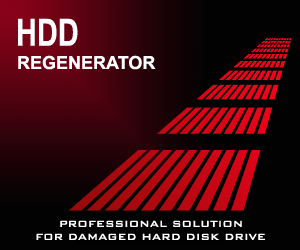 HDD Regenerator is truly like a magic wand that can repair bad sectors on your hard disk drive. This software package does this with a technique known as magnetic reversal. Of course, HDD Regenerator can only fix damage to the hard drive caused by magnetic problems. It can’t repair physical damage to the drive.
HDD Regenerator is truly like a magic wand that can repair bad sectors on your hard disk drive. This software package does this with a technique known as magnetic reversal. Of course, HDD Regenerator can only fix damage to the hard drive caused by magnetic problems. It can’t repair physical damage to the drive.Nonetheless, this is one mean software package that packs in support for multiple hard drive types and is capable of repairing problems that even low- level formatting processes can’t. Do you know what the best part is? It won’t even cause a loss of data while it works! HDD Regenerator is THAT good.
HDD Regenerator System Requirements:
When it comes to the system requirements, this one doesn’t make a fuss. It’s compatible with Windows XP, Vista and Windows 7/8. So any windows OS from the past 10 years is just fine and you’re good to go!
The Dual Plans of Action:
What happens if your hard drive crash killed the Operating System as well? What do you then?
Never fear, this HDD Regenerator takes care of that as well! In case the computer you want to repair doesn’t have a functional Operating System, this is what you do:
Go and install the HDD Regenerator software on any other computer that has Windows Vista, XP or Windows 7/8 and just make a bootable DVD/CD or flash drive which can regenerate the hard drive.
Once this is done, boot the damaged computer from this CD, DVD or Flash drive to initiate the repair process.
That’s right. HDD Regenerator allows you to begin the process both under Windows and DOS.
What about File Systems?
Like we said before, the HDD Regenerator doesn’t complain. It’s totally compatible and doesn’t kick up any temper tantrums, no matter what you seem to throw at it! HDD Regenerator was made to operate solely on the physical level.
On a practical level, this means that any kind of file system, FAT, NTFS, you name it, HDD Regenerator can handle it with easy and finesse. Even unformatted or un-partitioned disks aren’t a problem for HDD Regenerator.
However, this can sometimes lead to a few minor issues. For instance, since HDD Regenerator won’t touch the logical aspect of the hard disk, sectors logically flagged as “bad” will continue to be shown as such even after the regeneration process has been successfully completed. This can be fixed, though. If you want to remove these marks, you can repartition the drive.
How do I Install and Uninstall HDD Regenerator?
Once again, it’s a very simple process.
First, run the executable file associated with the HDD Regenerator, which launches the Installation wizard. The wizard then guides all the way across the entire process step by step — just click “Finish” when you’re done.
To remove the software from the system, just go to Add or Remove Programs in the Control Panel – Programs and Features in Windows 7/8 – and select “HDD Regenerator” from the program list.
Starting the HDD Regenerator
Starting the repair process is as simple as selecting the relevant icon on the Desktop or the Start Menu.
Of course, if you have an unregistered copy, you’ll only be able to recover the first bad sector found, with the program prompting you to start using the registered version to checks the entire hard drive.
To directly initiate the repair process under Windows – assuming the HDD damage didn’t kill your Operating System – just go to the “Regeneration / Required” option.
However, if you want to regenerate a drive that doesn’t have an Operating System, go to “Regenerate” / Relevant option to create a flash drive or “Regeneration” / Relevant option to create a DVD/CD.
So Far So Good, Now What Next?
Next, select the disk that you want to regenerate.
Then select between the two available modes – both of which are pretty self-explanatory.
Next, you must key in the initial sector value.
If you wish to check the entire disc for errors, leave this field set to zero. However, if, for instance, you know the first ‘x’ GB of the disk drive doesn’t have any bad sectors, then you will enter “x,” followed by “m,” in this field. The “x” is essentially the offset, and the factor “m” balances out the actual figure in terms of bytes.
Now, all you have to do is wait until the scan completes and you’re good to go.
All in all, HDD Regenerator is one software package that has a lot of potential since bad sectors are a problem that computer users all over the world have to face. On top of that, it’s also very flexible in terms of the different kinds of Operating Systems, Hard Disk Drive types and boot methods that it can support with no problems at all.
HDD Regenerator





















0 comments:
Post a Comment